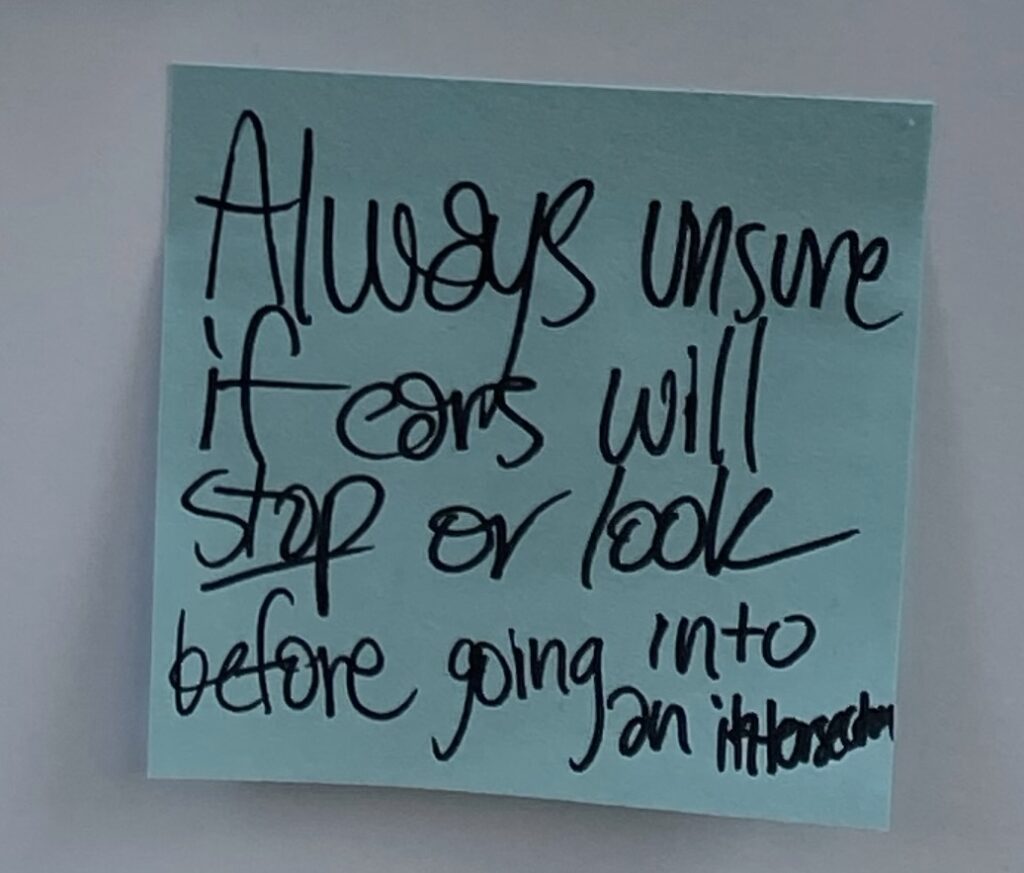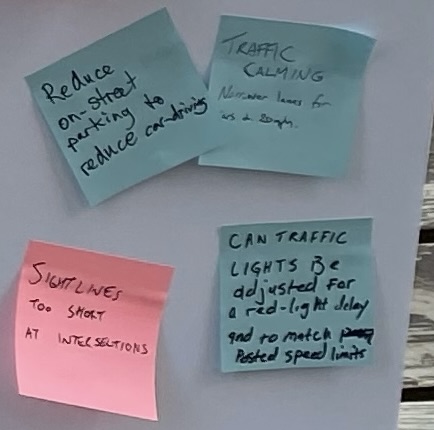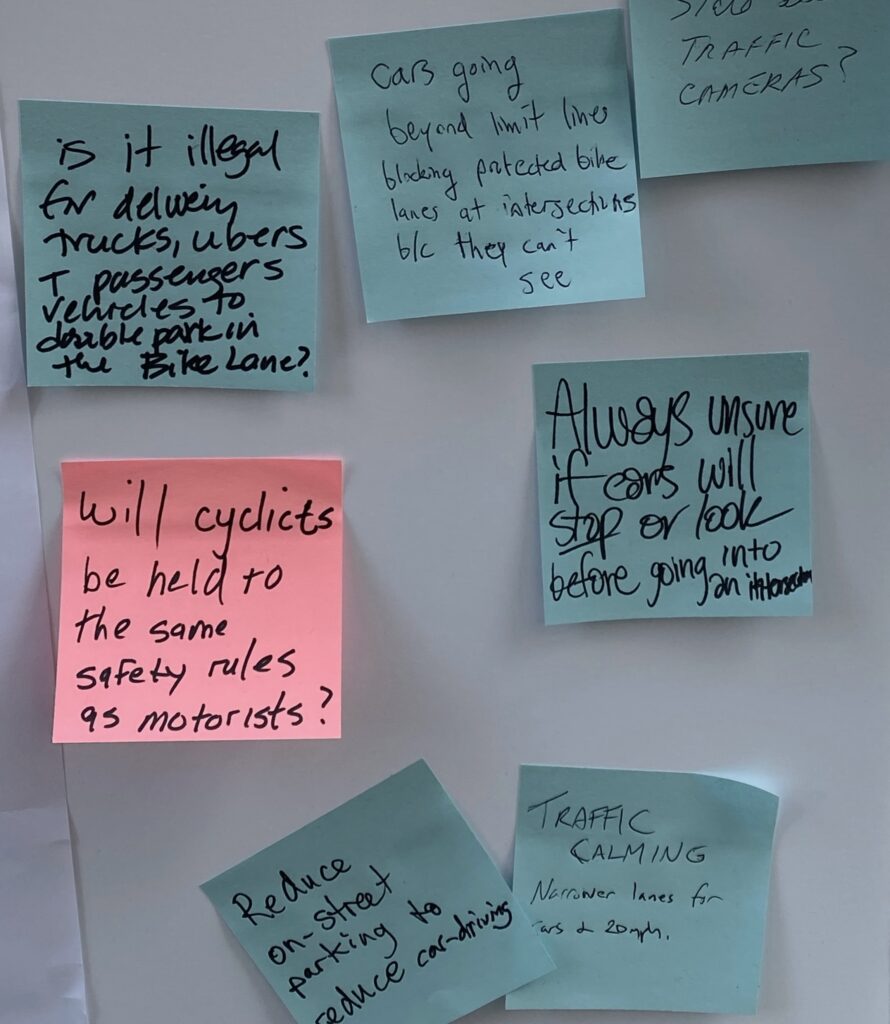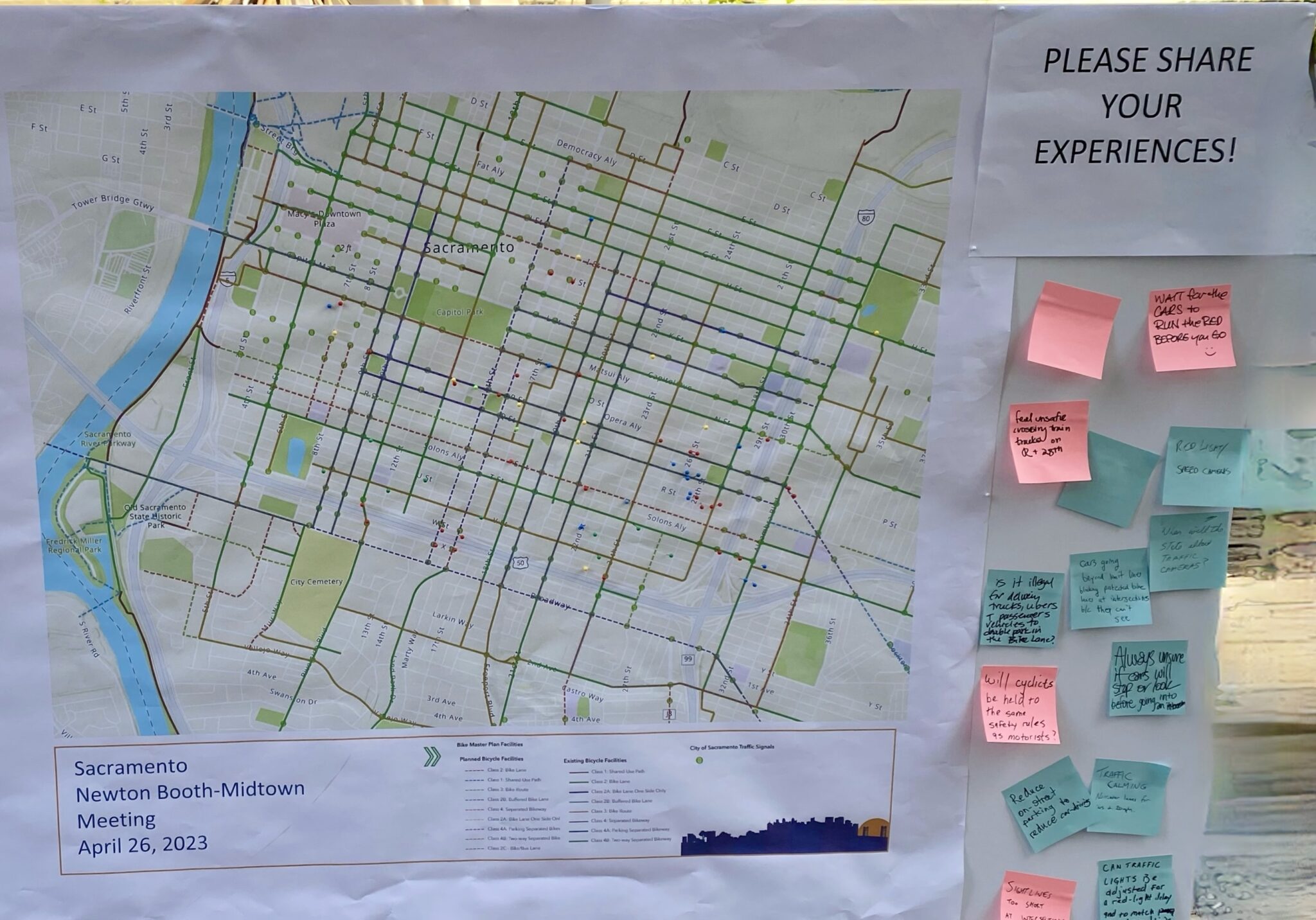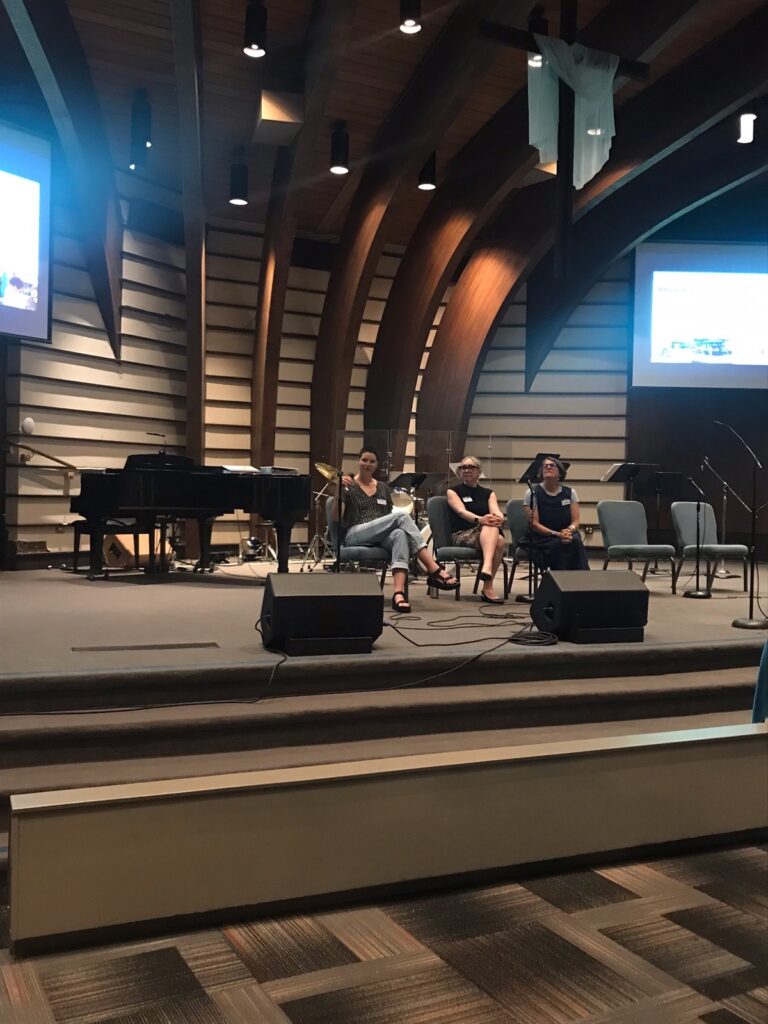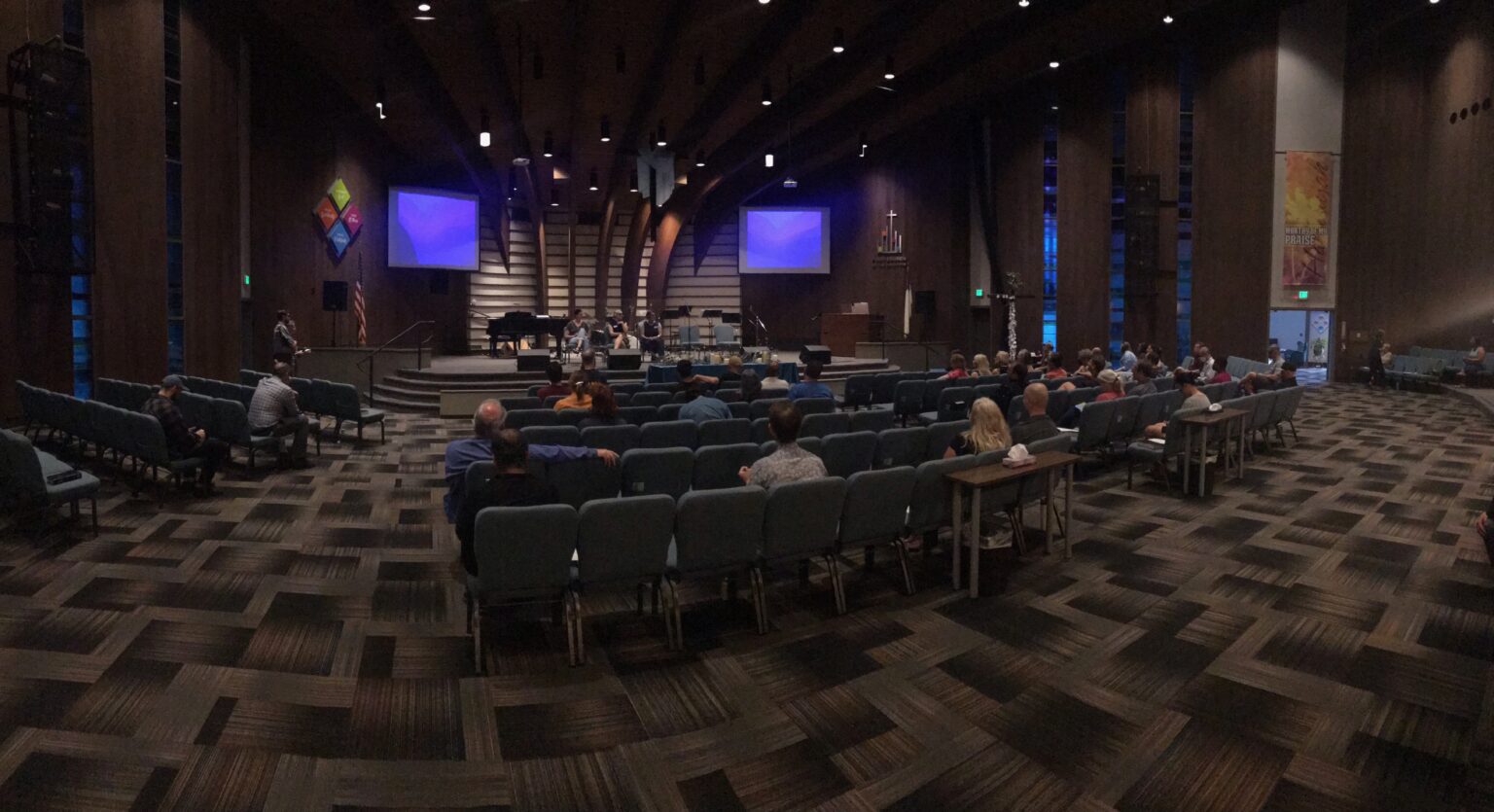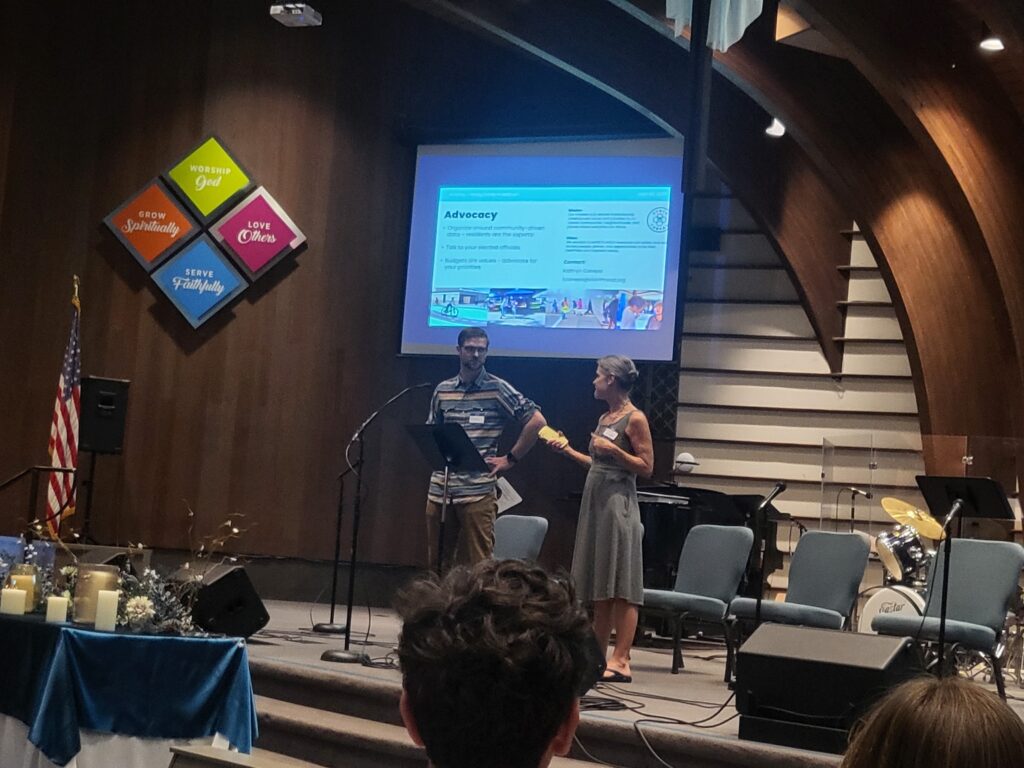- NBNA Initiatives
Making Biking and Walking Safer in Midtown

More Money, Better Policies Needed to Make Streets Safer, Residents Say
April 26, 2023 _ For biking and walking to truly feel safe in Sacramento – which tops the state in per-capita pedestrian deaths – the city needs to slow driving speeds and protect people from cars, advocates said Wednesday at a community meeting on biking and walking in Midtown.
Hosted by NBNA with MNA, the community meeting drew more than 60 people, including high school students, who came to learn about new protected bike lanes under construction along 21st Street and other places in Midtown and ask what else can be done to encourage safer biking and walking.
Freeway Under Crossings Problematic
“I am active person and I love to bike,” Wade, 14, told the crowd. “But if you live in Midtown, at some point you have to go under a freeway to get to another neighborhood. It’s a real barrier and I wish it felt safer.”
In a 90-minute question-and-answer session with city officials and bike/ped advocates, people shared example after example of ways in which local streets feel unsafe. Some talked about bike lanes that abruptly end. Others cited specific intersections that are dangerous, while a theme was how unsafe people feel crossing under elevated freeways.
A number of people asked about low-cost strategies for slowing traffic – such as lowering speed limits, or painting in crosswalks and adding art to asphalt on streets. (To see all the great questions the were asked via written note cards, scroll to the bottom of this story).
“How much does red paint cost?” one attendee asked, noting that a corner with a red curb near their home is much safer because it’s visible.
“What is the overall strategy?” another attendee asked. “How can we help advocate for an active transportation program operating budget?”
Funds a Constraint
The expert panel assembled – comprised of city Transportation Planning Manager Jennifer Donlon Wyant, Deb Banks of the Sacramento Area Bicycle Advocates and Kathryn Canepa of Civic Thread – agreed that while progress has been made, Sacramento, like nearly all cities, lacks adequate funding for its infrastructure problems.
In 2017, following high rates of fatalities, the City Council adopted Vision Zero, a policy which seeks to eliminate all pedestrian deaths.
“We are working hard to improve safety and the efforts are working,” Donlon Wyant said. The percentage of people killed or seriously injured while walking has decreased from 32% in 2016 to 21.4% in 2020, she said. Bicyclists saw a similar decline in those four years, from 16% to 9.3%.
Still, everyone agreed even one death is too many and urged the city to slow cars.
Money is a constraint: Sacramento faces $6.5 billion in street infrastructure needs, including backlogged repairs and maintenance and new projects. To guide scarce funds, the city has a Transportation Priorities Plan.
In Midtown, prioritized projects include protected bikeways that are currently under construction on 19th Street (H Street to Broadway), 21st Street (I Street to Broadway) and P Street (15th Street to 21st Street), among other streets.
Budget Presents Opportunity
Banks, executive director of SABA, said people who care about safer streets should organize around the city’s budget and demand more funding. She also suggested advocating for policy changes – like slower street speeds – and noted that is often more successful when “regular people” (instead of known advocates) show up at City Council meetings and speak up for change.
Finally, Banks encouraged people to become involved in conversations under way about the renewal of Measure A, the half-cent sales tax measure that supports transportation projects throughout the county.
Wednesday’s meeting was organized in response to a survey undertaken recently by NBNA, which found that few people feel safe walking and biking.
Dozens of Questions
NBNA handed out index cards during the meeting and asked neighbors to write down their questions. Below is what they wrote. Conversations about how to advocate for biking and walking safety will continue. Stay tuned for future meetings on this issue.
Freeway Underpasses:
- How can freeway under crossings be redesigned to make them appealing to pedestrians and cyclists? The under crossings currently discourage movement between neighborhoods.
- A theme shared by the youth who spoke, and a problem I experience frequently, is the difficulty of traveling from one side of the elevated freeways to the other. The bike lane, when there is one, just ends. The Central City is so hemmed in by the freeways – can we please just get one safe undercrossing running east-west and north-south?
Using Low-Cost, Near-Term Safety Fixes:
- Is the city of Sacramento interested in temporary/demo infrastructure that provide ped/bike safety at lower costs? How can the city create safer infrastructure cheaper?
- Has the city implemented or considered quick-build projects in past and will it leverage benefits of a quick build program to meet identified needs before capital projects come online?
- How much does red paint cost? I live at 25th and D and my corner has a red curb and it’s far safer than 25th and E that has an accident every month and rotten visibility for bikes, walkers and cars.
- Are there guerilla tactics to improve neighborhoods (in the short term)? Have you noticed any in Sacramento?
- When thinking of low-cost solutions, ie; lowering speed limits or restricting vehicular traffic, what can we do as a collective to bring change? Thank you.
Protected Bike Lanes – Questions, Clarifications
- Please provide more info on the 21st street bike lane. As presented at an earlier city planning meeting, it was going to be a protected lane on the west side ending at I street, which is a very dangerous corner with all the traffic turning left. It now looks like the lane is extended to H street. Please update us on the decision. Thanks
- Will the P/Q protected bikeways be delayed by the ACE train station delays?
- Any estimated timelines of completion for the Central City protected bike lane projects? (ie; expanding P/Q to 21st?
- What will change on 21st and 19th with the new protected bike lanes?
- Separated bike lane transitions (where intersections meet) are scary. I don’t always feel seen.
- Is there data re: protected bike lanes between 15th and 9th and P and Q as far as decreased speeds/accidents?
- Has the city studied bike solutions in other countries such as Scandinavia, where one car lane is a two-way bike lane separated by bollards? The separation from cars is critical! Bollards work!
Bike Safety
- Any thoughts about limiting street parking so that piles of leaves will be along curbs and not in the bike lanes? Also, so delivery drivers don’t use bike lanes as temporary parking?
- Can the city implement a more comprehensive plan to increase sightlines by having no parking/red curb w/in all intersections? Rather than the piecemeal 311 system?
- Not all streets are meant for all riders. Streets should have tiered wayfinding markers to identify safe, moderately safe, not so safe (using green, black, blue) and connected with a corresponding app.
- The discussion began with bike/walk safety. It sounds like car behavior like speeding is threatening the safety of cyclists and pedestrians. What is the plan to address driver behavior? And what does the research show that has the best results?
- Restripe, refresh bike lanes, crosswalks, trim trees
Pedestrian Safety – Sidewalks, Scooters, Etc
- What is being done about safety on sidewalks? Motorized: Bikes, scooters, skateboards, why not enforced?
- Many cyclists do not follow the rules of the road. Result: pedestrians and cyclists are in danger each and every day.
- What programs are planned to help educate bicyclists to ride safely and considerately? (ie; not ignoring stop signs and lights, not wearing earbuds, distracted riding, being visible at. Night? Also, skateboarders!
- What efforts are being taken to educate youth, public about rules of the road CVC 21200 et seq? How many riders know their roles on the bike? Pedestrians should walk against traffic.
- The City Council passed the Vision Zero declaration in 2017. There hasn’t been a single update to the project website since 2020. Where is the data and progress reports? It’s hard to believe the city takes this seriously if there’s no effort to measure progress.
Tools: Traffic Lights, Road Design, Enforcement, Education
- Is road design being considered to slow speeds?
- When will we see a delay between red and green at traffic lights? (Sacramento is the only city I’ve ever lived in where the change is simultaneous)
- Will there be more crosswalks that are activated with flashing lights when a pedestrian walks?
- Can traffic engineers implement new signal pattern lights? On the grid the lights go straight from red to green, leading to more cars running lights. Also, red light cameras!
- What is the local law regarding red lights and bikes? Can I treat a red light as a stop sign?
- Virtually nobody stops at stop signs. Frew drivers give the right of way to pedestrians who are already in the crosswalk.
- We need more enforcement of traffic laws to get people to start complying.
- Education: Need to educate the public re: CVC 21200 et seq.
- Enforcement: Needs to happen via law enforcement of motorists, bicyclists.
- Not all streets are meant for all riders. Streets should have tiered wayfinding markers to identify safe, moderately safe, not so safe (using green, black, blue) and connected with a corresponding app.
Transit
- Transit needs to be an option until dense building has occurred; what is being done to increase the hours transit is available?
- Can the city work with Sac Regional Transit to incentivize train/bus use? (Many years ago, there was a reduced rate for bus and train for travel on the grid only).
- You mentioned a high percentage of fatal and several crashes near transit. How are transit stops and corridors considered in the city’s transportation prioritization? (Every transit rider is a pedestrian or possibly a cyclist at some point in their trip).
Misc. – Del Rio Trail, Etc.
- The Del Rio Trail is behind my house. I’m looking forward to it. Yet I question why the Del Rio path goes right across Sutterville Road. That road is right off Hwy 5 and very busy – especially at commute time. Speeding has caused accidents and fatalities around that area. What are the plans to ensure cyclists are safe when they cross Sutterville on the Del Rio Trail?
- How does the unhoused impact the bike/walk project. If you build it people will use it unless it is bordered by unhoused encampments (under bridges, sidewalks) which can make younger riders scared.
- If lighting helps safety in neighborhoods, why should neighbors have to pay? Shouldn’t the decrease in associated service calls free up money?
